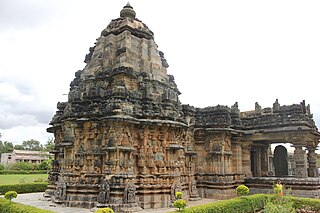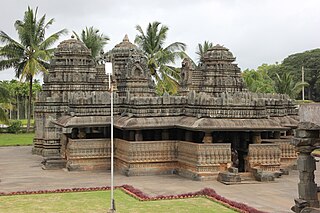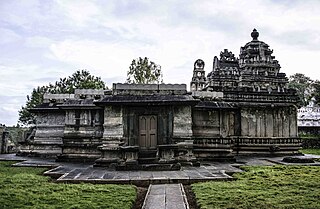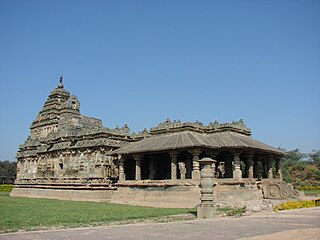Related Research Articles

Hoysala architecture is the building style in Hindu temple architecture developed under the rule of the Hoysala Empire between the 11th and 14th centuries, in the region known today as Karnataka, a state of India. Hoysala influence was at its peak in the 13th century, when it dominated the Southern Deccan Plateau region. Large and small temples built during this era remain as examples of the Hoysala architectural style, including the Chennakesava Temple at Belur, the Hoysaleswara Temple at Halebidu, and the Kesava Temple at Somanathapura. These three temples were accorded UNESCO world heritage site status in 2023. Other examples of Hoysala craftsmanship are the temples at Belavadi, Amruthapura, Hosaholalu, Mosale, Arasikere, Basaralu, Kikkeri and Nuggehalli. Study of the Hoysala architectural style has revealed a negligible Indo-Aryan influence while the impact of Southern Indian style is more distinct.

Halebidu is a town located in Hassan District, Karnataka, India. Historically known as Dwarasamudra, Halebidu became the regal capital of the Hoysala Empire in the 11th century CE. In the modern era literature it is sometimes referred to as Halebeedu or Halebid as the phonetic equivalent, a local name after it was damaged and deserted after being ransacked and looted twice by the forces of the Turko-Persian Delhi Sultanate in the 14th century.

Shravanabelagola is a town located near Channarayapatna of Hassan district in the Indian state of Karnataka and is 144 km (89 mi) from Bengaluru. The Gommateshwara Bahubali statue at Shravanabelagola is one of the most important tirthas in Jainism, one that reached a peak in architectural and sculptural activity under the patronage of Western Ganga dynasty of Talakad. Chandragupta Maurya is said to have died on the hill of Chandragiri, which is located in Shravanabelagola, in 298 BCE after he became a Jain monk and assumed an ascetic life style.

Lakshmi Narasimha Temple, also referred to as Lakshminarasimha temple of Bhadravati, is a 13th-century Hindu temple dedicated to Vishnu, built by the Hoysala ruler Vira Someshwara. It is located in Bhadravati, Shimoga District of Karnataka state, India. The temple opens to the east and has three sanctums, one each dedicated to Venogopala, Lakshminarasimha and Vishnu-Puroshottama. It is notable for its Vesara architecture, with artwork that includes legends and deities of Vaishnavism, as well as those of Shaivism, Shaktism and Vedic deities. Important reliefs include those of Ganesha, Dakshinamurti, Bhairava, Sarasvati, Brahma, Surya, Harihara, and others. The temple's original shikaras were ruined, and have been restored with a conical structure. According to Adam Hardy – a scholar of Indian temple architecture, this temple has two "exceptional" stellate structures highlighting the architectural sophistication of the Hoysalas.
Some famous temples built by the Western Chalukyas, referred to as the "Later Chalukya art" that flourished in and around the Tungabhadra River districts of modern Karnataka state, India, are included in the table below.

The Amruteshvara temple also spelt "Amrutesvara" or "Amruteshwara", is located in the village of Amruthapura, 67 km north of Chikmagalur town in the Chikkamagaluru district of the Karnataka state, India. Located 110 km from Hassan and 50 km from Shimoga on NH 206, Amruthapura is known for the Amruteshvara temple. The temple was built in 1196 C.E. by Amrutheshwara Dandanayaka under Hoysala King Veera Ballala II.

Bucesvara temple, also referred to as the Buceswara, Bucheshwara or Bhucheshvara temple, is a 12th-century Hindu temples in Koravangala village, Karnataka, India. The most sophisticated historical temple in the village, it is considered to be the flag-bearer of Hoysala architecture and was built by a wealthy patron named Buchi during the reign of king Ballala.

The Kalleshwara temple is located in the town of Hire Hadagali of the Hoovina Hadagalitaluk in Bellary district of Karnataka state, India.

The Mallikarjuna temple is located in the town of Kuruvatti in the Bellary district of Karnataka state, India. The temple was constructed in the early 12th century rule of the Western Chalukya Empire. The temple is protected as a monument of national importance by the Archaeological Survey of India.

The Kaitabheshvara temple is located in the town of Kubatur, near Anavatti in the Shimoga district of Karnataka state, India. The temple was constructed during the reign of Hoysala King Vinayaditya around 1100 AD. The Hoysala ruling family was during this time a powerful feudatory of the imperial Western Chalukya Empire ruled by King Vikramaditya VI. According to the Archaeological Survey of India, the architectural signature of the temple is mainly "Chalukyan". Art historian Adam Hardy classifies the style involved in the construction of the temple as "Later Chalukya, non mainstream, far end of spectrum". The building material used is soapstone The temple is protected as a monument of national importance by the Archaeological Survey of India.

The Kedareshvara temple is located in the town of Balligavi, near Shikaripura in the Shimoga district of Karnataka state, India. Dotted with centres of learning (agrahara), Balligavi was an important city during the 11th - 12th century Western Chalukya rule. The term Anadi Rajadhani used in medieval inscriptions to describe this town tells a tale of great antiquity. Art historian Adam Hardy classifies the style involved in the construction of the temple as "Later Chalukya, non mainstream, relatively close to mainstream". He dates the temple to late 11th century, with inscriptional evidence of additions made up to 1131, by the Hoysalas during their control over the region. The building material used is soapstone. The Archaeological Survey of India classifies the style of architecture as distinctly Hoysala. The Hoysala ruling family was during this period a powerful feudatory of the imperial Western Chalukya Empire, gaining the trappings of independence only from the period of King Vishnuvardhana. The temple is protected as a monument of national importance by the Archaeological Survey of India.

The Nageshvara-Chennakeshava temple complex, sometimes referred to as the Nagesvara and Chennakesava temples of Mosale, are a pair of nearly identical Hindu temples in the village of Mosale near Hassan city, Karnataka, India. One for Shiva, other for Vishnu, this pair is a set of highly ornamented stone temples, illustrating the Hoysala architecture. These temples also include panels of artwork related to the goddess tradition of Hinduism (Shaktism) and Vedic deities. Another notable feature of these temples is the artwork in their ceilings, how the shilpins (artisans) integrated the historic pre-Hoysala architectural innovations from the Chalukya era. Further, the temples include north Indian Bhumija and south Indian Vesara aedicules on the outer walls above the panels. It is unclear when this temple pair was built, but given the style and architectural innovations embedded therein, it was likely complete before 1250 CE.

Kedareshwara Temple is a Hoysala era construction in the historically important town of Halebidu, in the Hassan district of Karnataka state, India. It is located a short distance away from the famous Hoysaleswara Temple. The temple was constructed by Hoysala King Veera Ballala II and his Queen Ketaladevi, and the main deity is Ishwara. The temple is protected as a monument of national importance by the Archaeological Survey of India.

Panchalingeshwara Temple in Govindanahalli, Mandya district, Karnataka state, India, was constructed around 1238 A.D. during the reign of the Hoysala empire King Vira Someshwara. The name "Panchalingeshwara" literally means "five linga". The temple is protected as a monument of national importance by the Archaeological Survey of India. The famous sculptor of Hoysala times, Ruvari Mallitamma, is known to have made contributions to the temple.

The Rameshvara temple is a 12th-century Shiva temple in Kudli, Shimoga district, Karnataka India. It is an early non-ornate, Hoysala construction with simpler Vesara style. The village of Koodli – also spelled Kudli, Kudali – was a major town through the 14th-century and of great antiquity, with ruins of over eight major Hindu temples and monasteries. It is located about 18 kilometres (11 mi) north-east of Shimoga city, the district headquarters. The town gets its name because it is situated at the confluence of the Tunga and Bhadra tributaries that form the Tungabhadra river.

The Saumyakeshava temple at Nagamangala was constructed in the 12th century by the rulers of the Hoysala empire. Nagamangala is a town in the Mandya district of Karnataka state, India. It is located 62 km from the historically important town Mysore, on the Srirangapatna-Sira highway. Historically, Nagamangala came into prominence during the rule of Hoysala King Vishnuvardhana when it became an important center of Vaishnava faith and received patronage from one of his queens, Bommaladevi. During the rule of Veera Ballala II, Nagamangala prospered as an agrahara and had the honorific Vira Ballala Chaturvedi Bhattaratnakara. The temple is protected as a monument of national importance by the Archaeological Survey of India.

Akkana Basadi is a Jain temple (basadi) built in 1181 A.D., during the rule of Hoysala empire King Veera Ballala II. The basadi was constructed by the devout Jain lady Achiyakka, wife of Chandramouli, a Brahmin minister in the court of the Hoysala king. The main deity of the temple is the twenty-third Jain Tirthankar Parshwanath. The temple is protected as a monument of national importance by the Archaeological Survey of India. It is part of an Archaeological Survey of India Adarsh Smarak Monument along with other temples in the Shravanabelagola group of monuments.

The Brahma Jinalaya, sometimes called as the Greater Jain Temple of Lakkundi, is an early 11th-century Mahavira temple in Lakkundi, Gadag District of Karnataka state, India. The temple is attributed to Attiyabbe, the wife of the local governor Dandanayaka Nagadeva. It faces east, has a mukhamandapa, a gudhamandapa and its sanctum is covered by a sur-temple style vimana superstructure. The temple is notable for its reliefs depicting Jaina artwork, statues of the Tirthankaras and the two statues of Brahma and Saraswati inside its inner mandapa.

The Group of temples at Talakadu, located about 45 km south-east of the culturally important city of Mysore in the Karnataka state of India are ancient Hindu temples built by multiple South Indian dynasties. Archaeological excavations of the sand dunes at Talakad have shown the existence of several ruined temples built during the rule of the Western Ganga dynasty (c.345-999). However, according to historian I. K. Sarma, only two temples, the Pataleshvara and Maraleshvara, built during the reign of King Rachamalla Satyavakya IV (r.975-986) are intact. According to the Archaeological Survey of India (ASI), the Vaidyeshvara temple, the largest, the most intact and ornate of the group bears Ganga-Chola-Hoysala architectural features. Its consecration is assignable to the 10th century with improvements made up to the 14th century. According to the art historian Adam Hardy, the Kirtinarayana temple was built in 1117 A.D. by the famous Hoysala King Vishnuvardhana to celebrate his victory over the Cholas in the battle of Talakad. It has currently been dismantled by the ASI for renovation. Only its mahadwara is intact. The Sand dunes of Talakad are protected by the Karnataka state division of the ASI. The Vaidyeshvara and Kirtinarayana temples are protected as monuments of national importance by the central Archaeological Survey of India.

Govindanahalli is a small village in Mandya district of Karnataka state, southern India.
References
Citations
- ↑ Hardy(1995), pp317-348
- ↑ "Monuments of Bengaluru circle". ASI Bengaluru circle. Archaeological Survey of India. Archived from the original on 25 June 2012. Retrieved 30 August 2012.
- ↑ Foekema (1996), p. 57
- ↑ Hardy (1995), p. 326
- ↑ Foekema (1996), p. 47
- ↑ Hardy (1995), p. 325
- ↑ Foekema (1996), p. 59
- 1 2 3 Hardy (1995), p. 329
- ↑ "Parsvanatha Basti". Archaeological Survey of India, Bengaluru Circle. ASI Bengaluru Circle. Archived from the original on 18 November 2017. Retrieved 17 November 2017.
- ↑ "Shantinatha Basti". Archaeological Survey of India, Bengaluru Circle. ASI Bengaluru Circle. Archived from the original on 28 November 2016. Retrieved 15 August 2015.
- ↑ "Adinatha Basti". Archaeological Survey of India, Bengaluru Circle. ASI Bengaluru Circle. Archived from the original on 18 April 2016. Retrieved 15 August 2015.
- 1 2 3 4 Hardy (1995), p. 334
- ↑ "Rameshvara Temple". Archaeological Survey of India, Bengaluru Circle. ASI Bengaluru Circle. Archived from the original on 29 October 2013. Retrieved 15 August 2015.
- ↑ Foekema (2003), p. 59, p. 72
- ↑ Foekema (1996), p. 77
- ↑ Hardy (1995), p. 343
- ↑ Foekema (2003), p. 37
- ↑ Foekema (1996), p. 37
- ↑ Hardy (1995), p. 320
- ↑ Foekema (1996), p. 81
- ↑ Hardy (1995), p. 339
- ↑ Foekema (1996), p. 53
- ↑ Hardy (1995), p. 324
- ↑ Foekema (1996), pp. 62–63
- ↑ Foekema (1996), p. 41
- ↑ Hardy (1995), p. 321
- 1 2 3 Hardy (1995), p. 331
- ↑ Cousens (1926), p. 93
- ↑ Hardy (1995), p. 324
- ↑ Foekema (1996), p. 43
- 1 2 Foekema (1996), p. 67
- ↑ Hardy (1995), p. 328
- ↑ "Panchalingeshvara Temple". Archaeological Survey of India, Bengaluru Circle. ASI Bengaluru Circle. Archived from the original on 2 May 2015. Retrieved 15 August 2015.
- 1 2 Foekema (1996), p. 83
- 1 2 Hardy (1995), p. 340
- ↑ Foekema (1996), p. 71
- ↑ Hardy (1995), p. 332
- ↑ Foekema (1996), p. 73
- ↑ Hardy (1995), p. 333
- ↑ Hardy (1995), p. 321
- ↑ Foekema (1996), p. 39
- ↑ Foekema (1996), p. 87
- ↑ Hardy (1995), p. 346
- ↑ Hardy (1995), p317
- ↑ Foekema (2003), p37
- 1 2 3 4 Hardy (1995), p347
- ↑ Collyer (1990), p41
- ↑ Hardy (1995), p321
- ↑ Foekema (2003), pp75-76
- ↑ Hardy (1995), p338
- ↑ Hardy (1995), p331
- ↑ Hardy (1995), p332
- ↑ Foekema (2003), p72
- ↑ Sathyan B.N. (1965), p99, Karnataka State gazetteer, Bangalore, Govt. Press
- ↑ Hardy (1995), p324
- 1 2 Hardy (1995), p326
- ↑ Hardy (1995), p339
- ↑ Foekema (2003), p75
- ↑ Hardy (1995), p334
- ↑ Hardy (1995), p343
- ↑ Hardy (1995), p317
- ↑ Hardy (1995), p338
- ↑ Foekema (2003), p58
- ↑ Foekema (2003), p69,75,76
- ↑ Hardy (1995), p343
- ↑ Foekema (2003), p75,76
- ↑ Foekema (2003), p75
- ↑ Hardy (1995), p348
- 1 2 3 Hardy (1995), p325
- ↑ Foekema (2003), p76
- ↑ Hardy (1995), p342
- ↑ Foekema (2003), p76
Bibliography
- Hardy, Adam (1995) [1995]. Indian Temple Architecture: Form and Transformation : the Karṇāṭa Drāviḍa Tradition, 7th to 13th Centuries. New Delhi: Abhinav. ISBN 81-7017-312-4.
- "Monuments of Bengaluru Circle, Archaeological Survey of India-Various districts of Karnataka". Archaeological Survey of India (ASI). Archived from the original on 25 June 2012. Retrieved 30 August 2012.
- Foekema, Gerard (2003) [2003]. Architecture decorated with architecture: Later medieval temples of Karnataka, 1000–1300 AD. New Delhi: Munshiram Manoharlal Publishers Pvt. Ltd. ISBN 81-215-1089-9.
- Collyer, Kelleson. The Hoysala Artists, Their Identity and Styles. Directorate of Archaeology and Museums.